
Looking down East Church Street in 1981 when Rod's Big M was there and before they tore down the house next to it for a parking lot
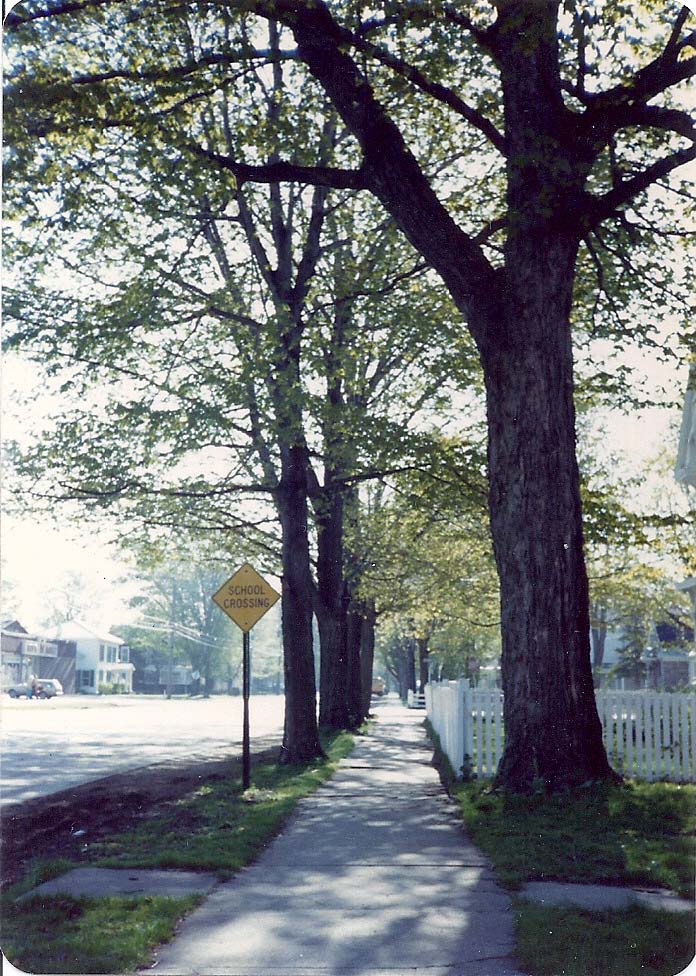
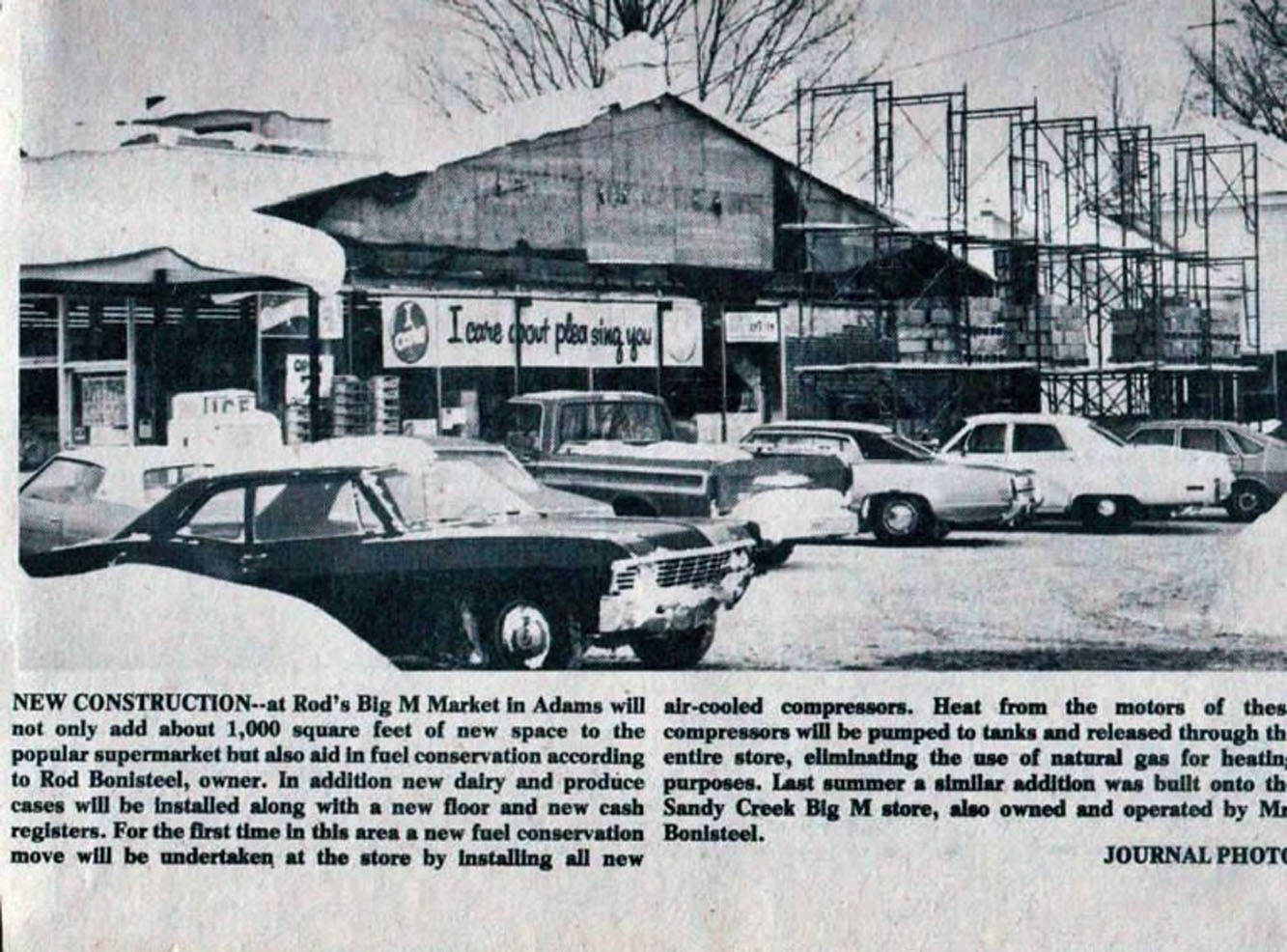
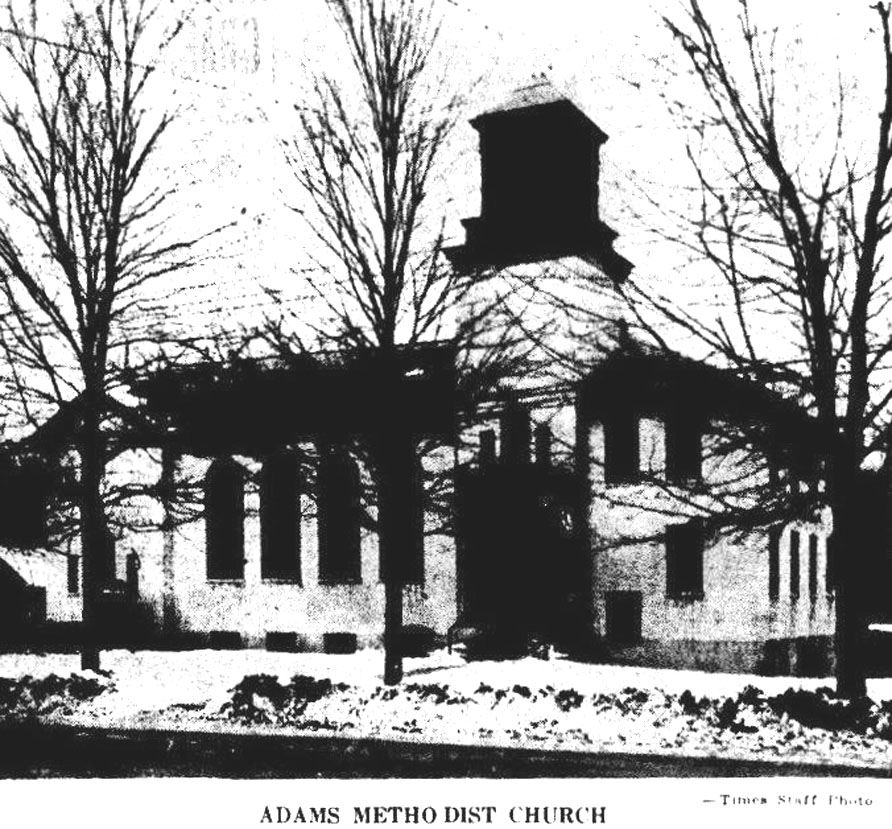
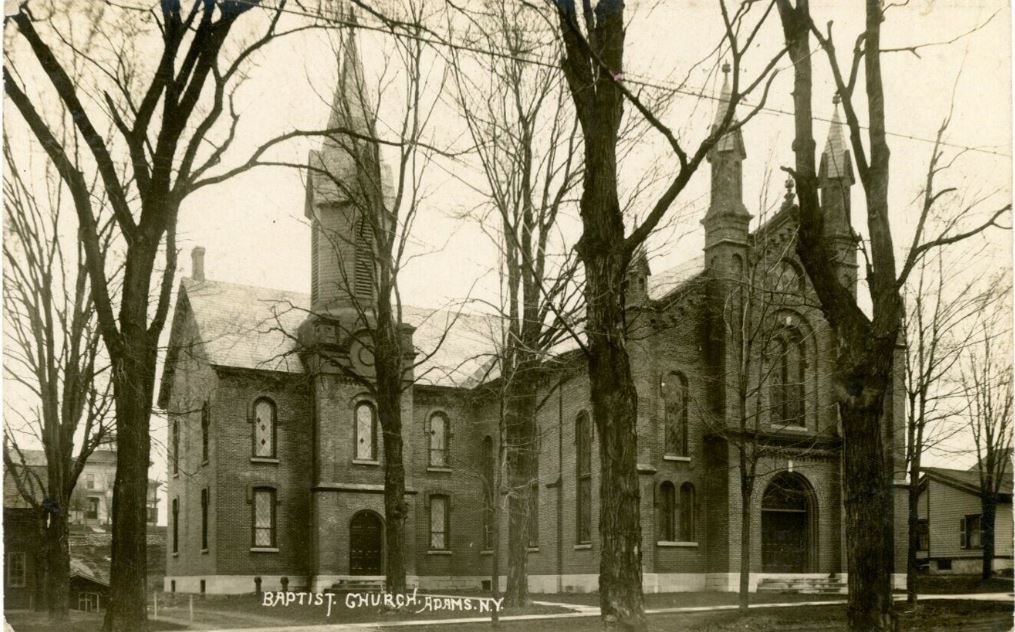
BELOW: Image from the 2005 Jefferson Co Journal Commemorative Publication:
Looking out outer East Church St....
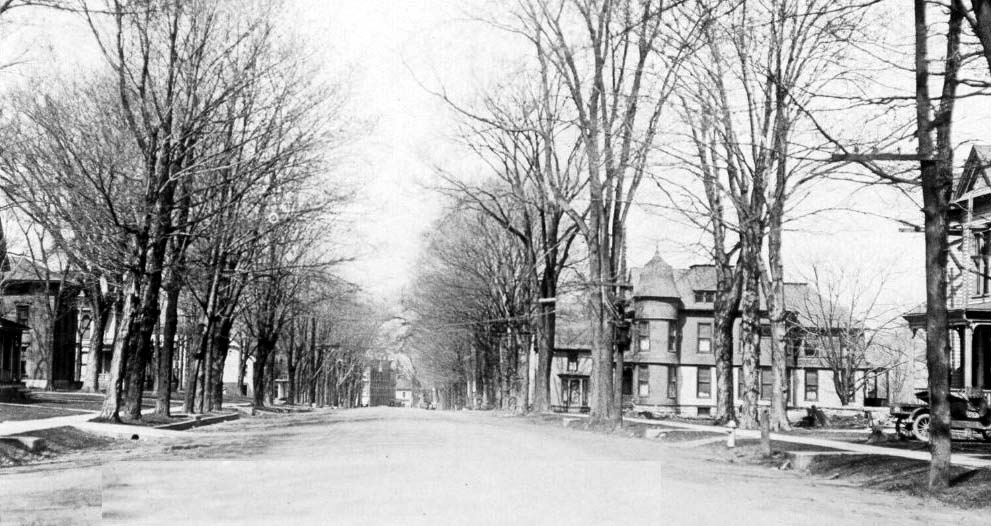
BELOW: Image from the 2005 Jefferson Co Journal Commemorative Publication:
parade om East Church Street
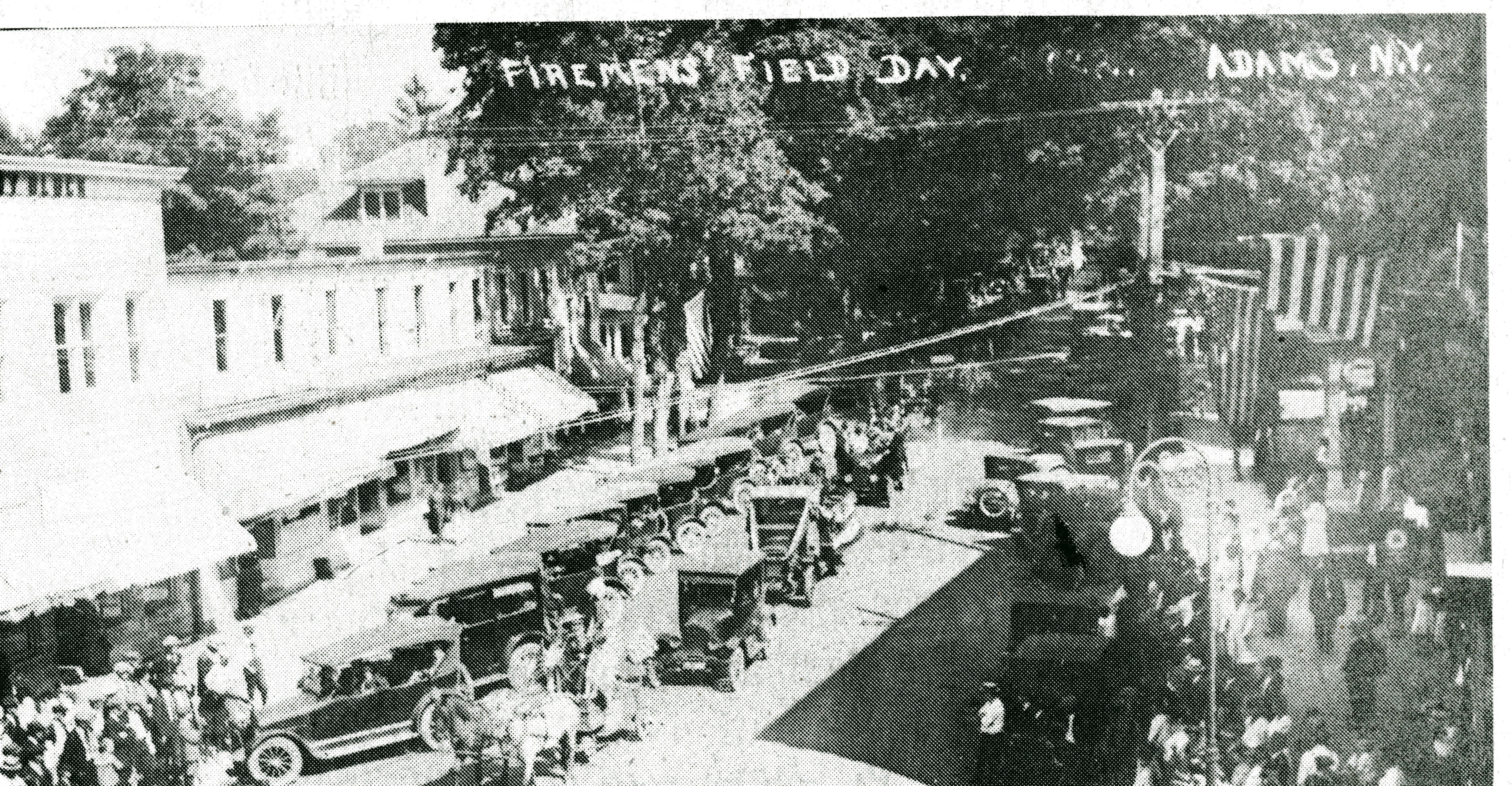
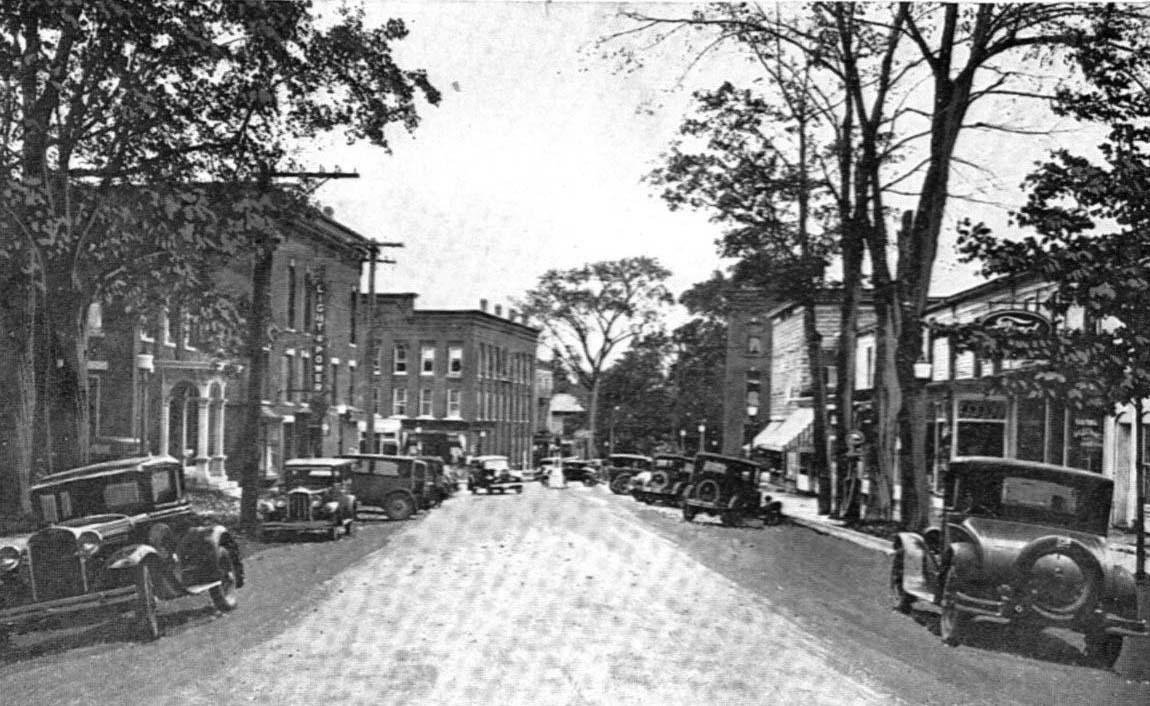
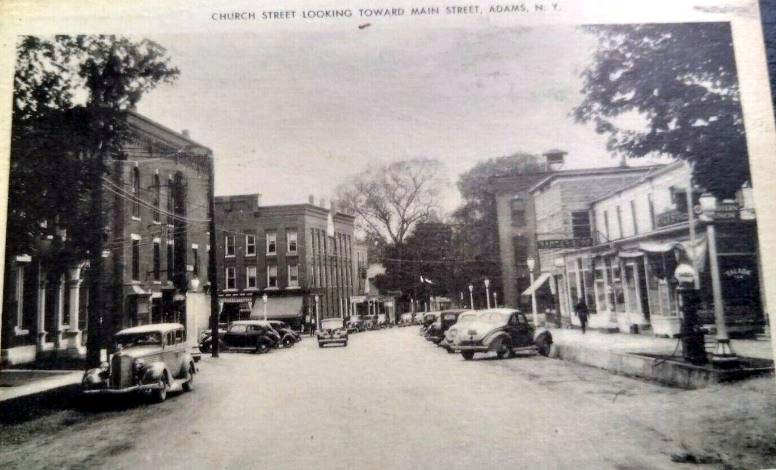
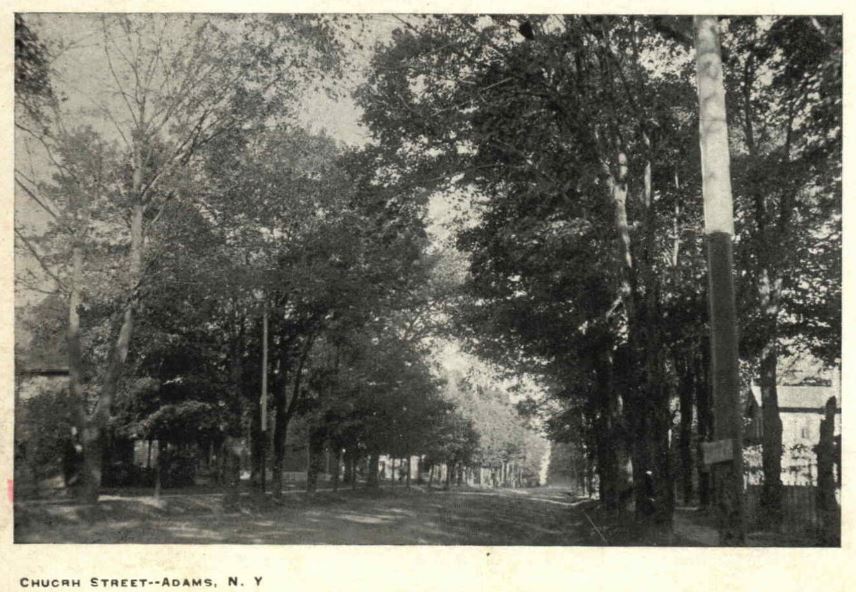
BELOW:
The Brick Mansion at 37 East Church Street in Adams located on Meeting
House Square this Georgian Colonial Mansion
has a rich history. The Jefferson County Bank , the oldest bank building
standing in Jefferson County, probably was built in 1816 and business
opened June 20 1817. It was later moved to Watertown .
Besides being the County's First Bank building it was also used as a school in 1829 and again in 1856. Behind this building and to the left as you face it is a single foundation that was probably where the site of the Adams Seminary was located. This was a school for females tought by Miss Willard of Troy. Later it was occupied by the Presbyterian Society for a session room or chapel. Among owners were P C Maxon in 1864.
From 1833 to 1852 the home belonged to the Dockstader (also spelled Doxtator)
family who Trace their ancestry to Pioneer Peter Dockstader first to
receive a deed of land in Adams. It went through a series of owners and
uses until 1931 when it again became a private residence
having been willed to Marry H Whittier wife of Clarence A Whittier former
mayor of Adams and distant relative of the poet
John Greenleaf Whittier. The Brick Mansion was purchased and made into
an apartment dwelling by Otis Edgar whose son
Donald J Edgar, and then sold to Bruce Thomas
BELOW: Image from the 1909 Firemens' Souvenier Book:
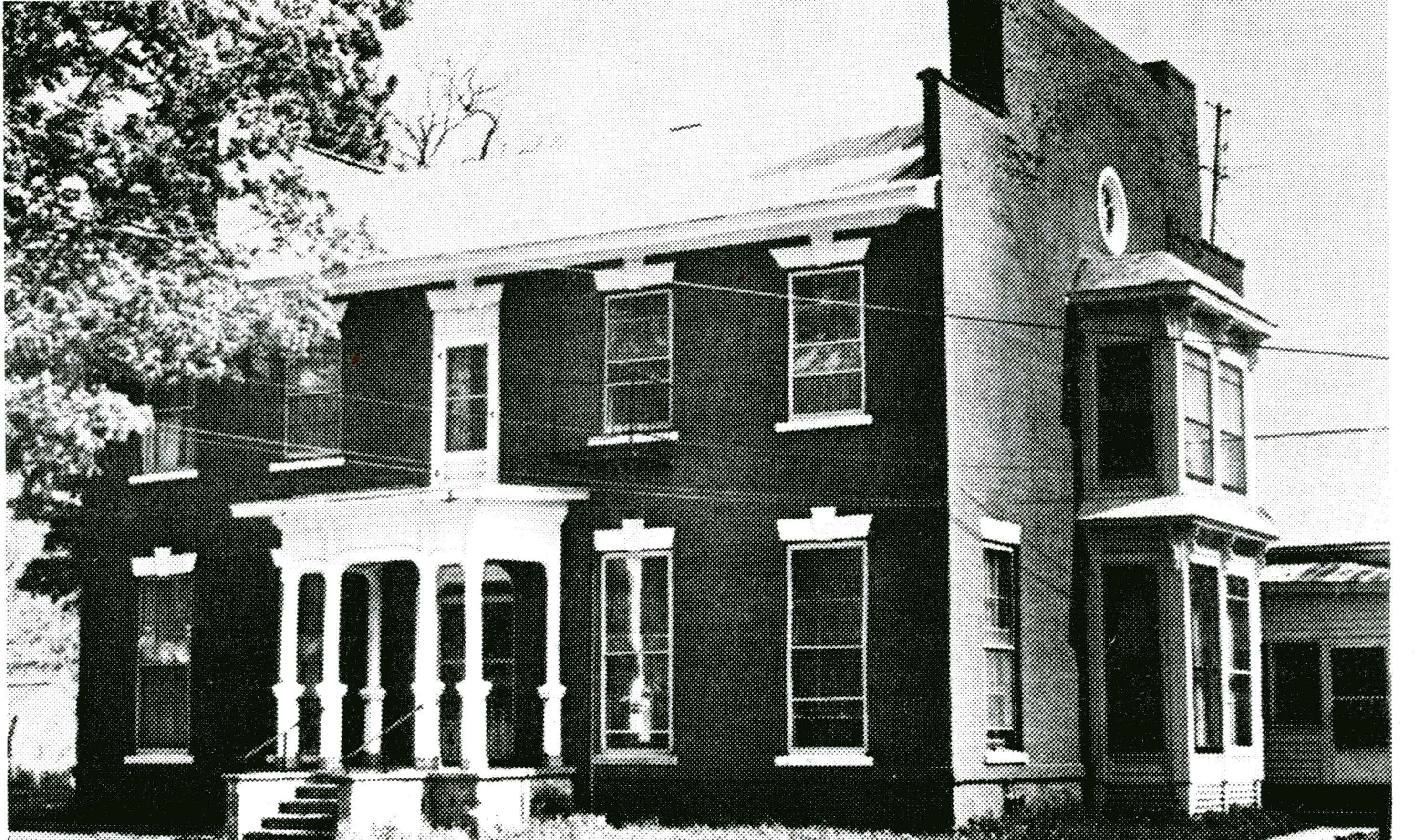
We lived at 37 East Church Street at
the time the Annex caught fire.
The brick building was unharmed and no one hurt
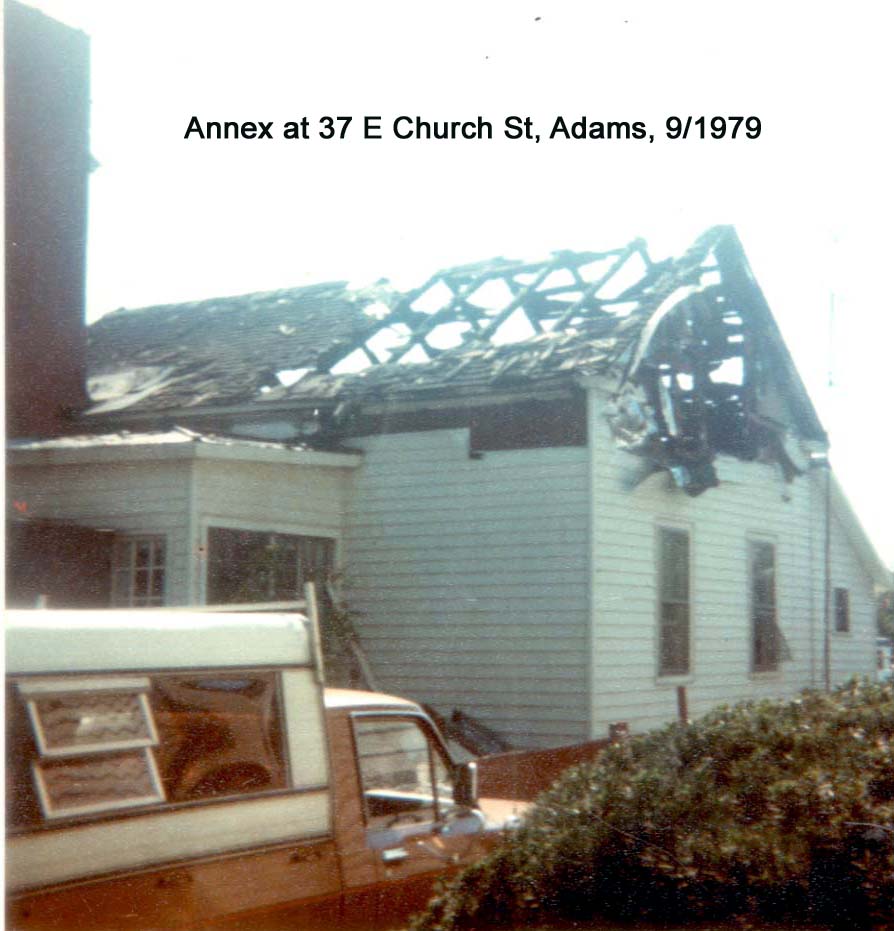
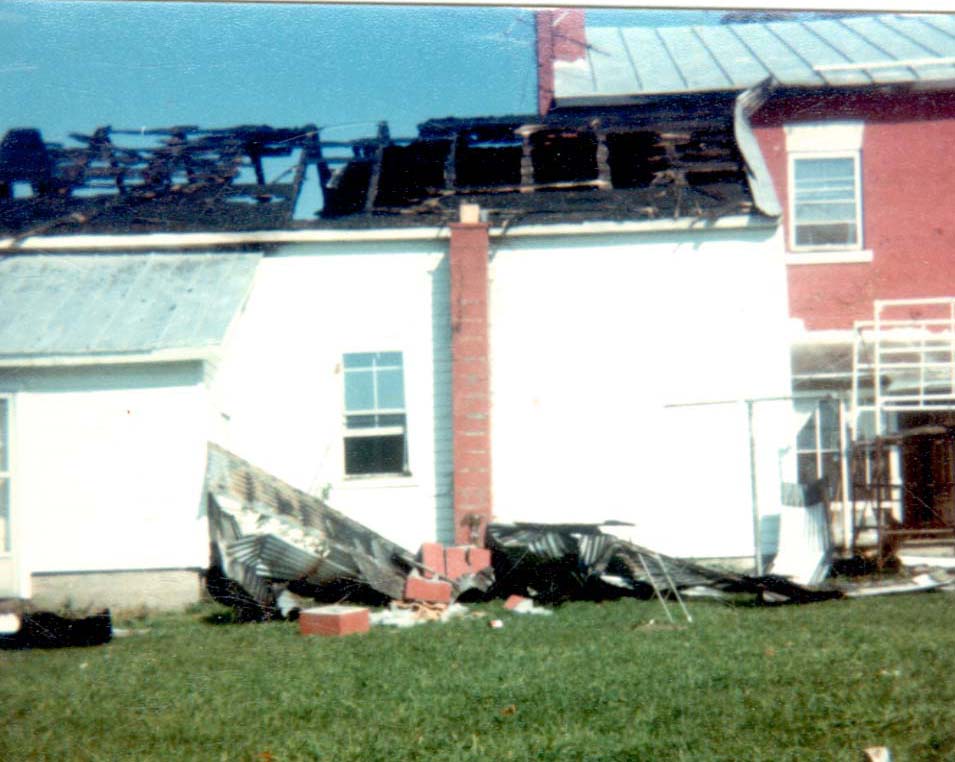
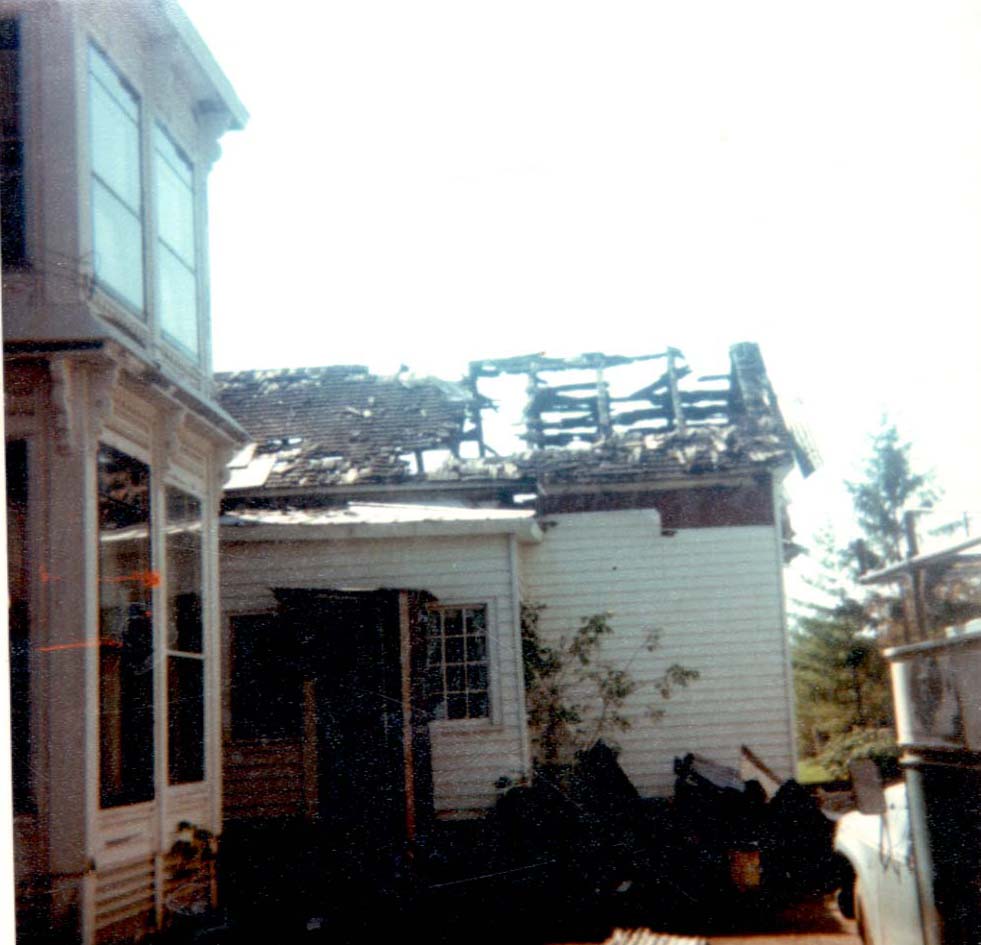
Below in 1980:
Robbins Farm Supply moved here from Adams Center.
It was Gleason's IGA and also the Grand Union
Below 1980:
Looking up East Church Street at what is now the Mason Hall. It was
the Presbyterian church, the oldest in town organized in 1803.
Charles G Finney preached in this church afterwards becomng an evangelist.
The original site of the Presbyterian church was where
the Methodist church is. The Presbyterians built their new church across
the street in 1827 where it still stands even after having been
struck by lightning during a service in 1828.
BELOW: Image from the 1909 Firemens' Souvenier Book:
Below 1980:
looking out East Church St...the picture includes the Methodist Church, the Shop'N'Go Plaza (now Mercer's) which houses the Jreck Sub Shop, Mercer's and the Watertown Savings Bank.
The Methodist Church is pastored by Reverend Roland Perkins. The church
was organized in 1827 and their first place of worship was
bought from the Presbyterians which later burned and in 1852 a new one
was built on the same site.
BELOW: 61 East Church Street
Below 1980
Baptist church, Pastor Peter Bolster, was organized
in 1805. First Adams site was
built in 1838 after moving here from the Adams Center area.
BELOW: Image from the 1909 Firemens' Souvenier Book:
BELOW: Image from the 1909 Firemens' Souvenier Book:
BELOW: Image from the 1909 Firemens' Souvenier Book:
BELOW: Image from the 1909 Firemens' Souvenier Book:
Church Street - R Snyder Residence
BELOW: Image from the 1909 Firemens' Souvenier Book:
Below in 1980
This post office was built in the 1960's
and prior to that it was a lovely home owned by the Stell Family.
The house and the barn were torn down and burnt to make space. Prior to
being here, the Post Office
was located downtown in what was later occupied by Lucy's, a ladies' clothing
store in the left side only.
The post office was established in Adams in 1806
Below:
Old Reynolds home this imposing chalet type home on the corner of North Park and Church Street formerly owned by the Reverend Mr. Reynolds and son was demolished to make room for Rod's Big M store
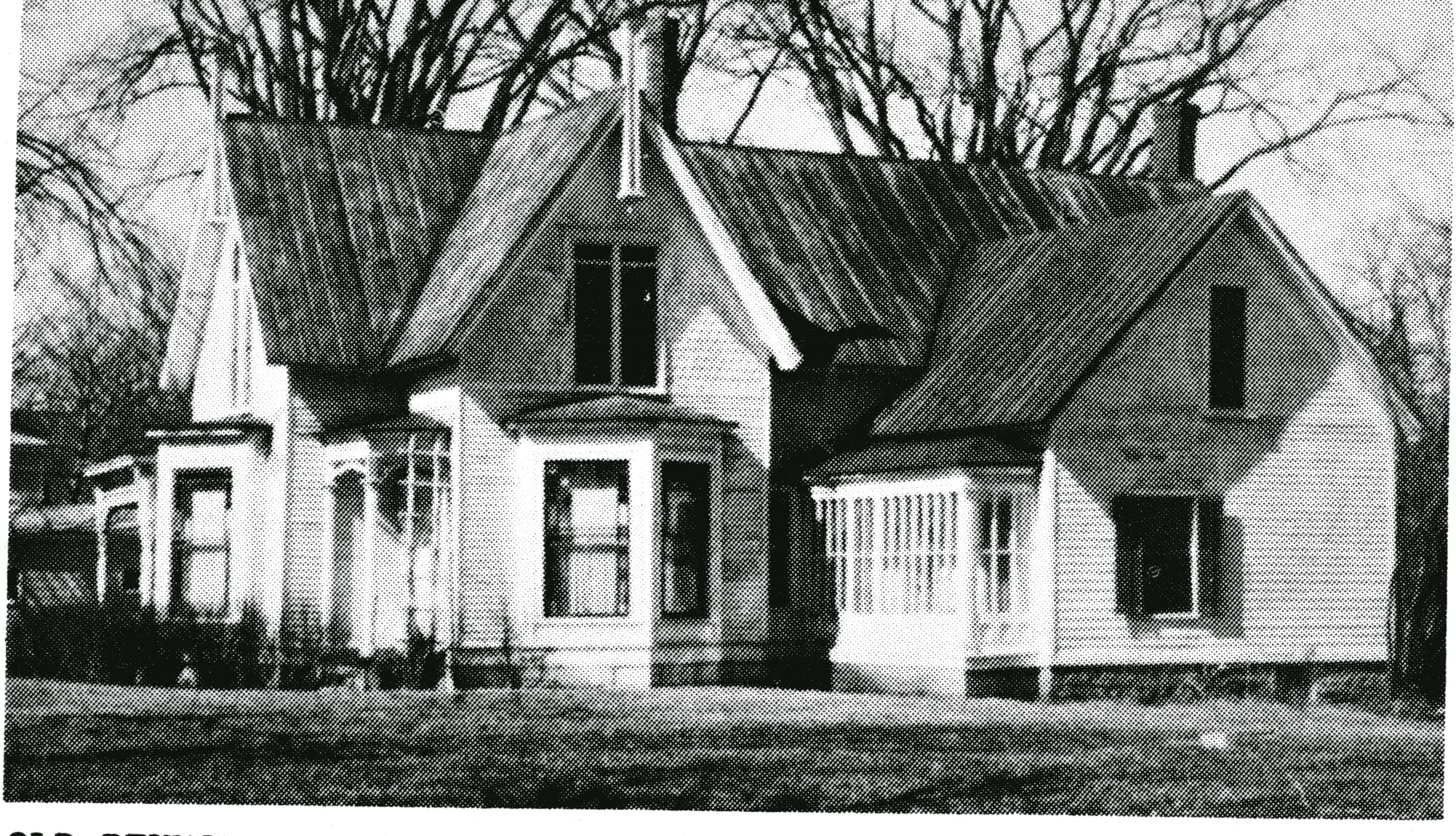
Below:
November 1980, the Burning of the Methodist Parsonage, last inhabited
by
Charles Stewart and family, was located at 38 East Church Street and was
the location on the parsonage for over 100 years. In 1885, a new parsonage
was built here
Below:
November 1980, the Burning of the Methodist Parsonage
Below:
November 1980, the Burning of the Methodist Parsonage
Below:
November 1980, the Burning of the Methodist Parsonage
Below:
November 1980, the Burning of the Methodist Parsonage
Below in 1980:
looking down East Church street from the intersection. From buildings right to left are:
Dr Kirk Williams, dentist
Shear Delight (pinkish facade) hair dresser
An apartment building
A barber shop operated by Gary Sweet
Florist Shop operated by Cal Thompson
and the CAPC - Outreach Center
Below in 1980:
Looking up East Chruch Street from the intersection
The first building is the Bundy Block which burned in 1918 The bottom
floor is the CAPC and the upper
floor is supposed to be where meetings are held for ACT II a newly formed
organization to revitalize Adams.
Also in the past, other stores that occupied this area were:
Surprise Store (clothing)
A candy Store - see the article
a gas station and more...
South Jefferson revisited, pubished in 1980, by Joe Valley:
THE DAY THE CANDY STORE BURNED
It was a cold, blustery night and the chief of police,
Henderson Blair, was making his rounds
to be sure that the Village of Adams was safely tucked in. Saturday night,
usually a night of
street activity, had been quiet this night. A lot of 'the boys' had been
sent overseas to fight the
great war, and the older folks had long ago retired for the night.
The nineteenth amendment was being voted on by the
various states, heading for ratification,
but was not yet final. The Chief knew that if and when it was put into
law, there would be many
a quiet Saturday night along Main street. He also knew that the enforcement
of the prohibition
law would add to his problems too.
It was about 1:45 AM on Sunday, March 3rd that the
Chirf first smeeled smoke. the year was 1918.
The smoke smelled of grease and wood and paper and he followed his nose
to its source. It was coming
from the northeast corner of the Frasier and Pitcher Block on the corner
of Main and Church Street.
The location of the smoke was in the rear of the F M Williams Restaurant.
On closer inspection, the
Chief could see the flicker of the flames on the resataurant kitchen ceiling
and the Chief hastily sounded
the alarm. the firemen arrived quickly, rubbing the sleep from their eyes
and soon had several streams of
water playing on he clapboard building, but the entire building seemed
to be filled with smoke that soon
burst into a mass of flames. The flames moved quickly to the adjacent
Ackerman Block on Church Street.
The upper floor of the Frasier and Pitcher Building
held the dental office of Dr R T Kirkland, but the big
worry was the residents of the two housekeeping apartments on that floor.
Mr and Mrs Carl Jimerson
occupied one of these apartments. They had been aroused by the shouting
and activity on the street
and they barely escaped with their lives. Mrs Jimerson attempted to gather
some of their personal
property but was forced to jump from the window to the waiting firemen.
All of their personal papers,
furniture, and memorabilia were devoured by the flames. They had no insurance.
Mr and Mrs Charles Cushman were the other tenants
on the second floor and the last to be aroused.
Charlie lowered his wife out the window, but had to let go because of
the intense heat and she fell,
spraining her wrist and ankle very severely. Mrs Cushman also suffered
from nervous shock that would
take many months to overcome. Charlie Cushman also jumped from the second
floor window after trying
to locate the little family dog. The dog apparently panciked and hidden
somewhere in the apartment.
The dog was to become the only fatality of the fire.
People were gathering in the streets on this early,
cold March morning. Some came to give aid to the
firemen, some of the ladies brought coffee and snacks for the firefighters,
and some people came just
to watch. The boys from the high school were very helpful in fighting
this blaze.
The firemen soon called for their steamer which
was stationed over on Railroad Street (now West Church St).
The steamer had five lines, the full capacity soon playing on this fire
which by now had gotten out of hand.
Their job now was to try to confine it to just the Frasier and Pitcher
Block and the Ackerman Block as it
had already spread to that structrure. The clapboard building and the
brisk winds contributed to the
fierceness of the flames.
There were other families on the second floor of
the Ackerman Block which was owned by C R Ackerman
of Brier Hill. They had ample warning to get out of their apartments before
the fire reached them but their
furniture and property were a complete loss. The families that shared
the second floor of this building were:
Dan Hess and his family; Abner Hess and his family and well as Mrs Mamie
Giddings and her son Johnny and
daughter Fanny. This was no new experience for the Giddings family. It
was the third time they had been
burned out, and the second time within five years. The families in the
fire would all be taken care of by
relatives until they could find other housekeeping facilities.
The business establishments in the dwntown portion
of the building suffered the greatest monetery loss.
The WOmen's Specialty Shop was already in flames by the time the steamer
arrived. This shop was owned by
Miss Henrietta Stillman abd had a larger-than-normal stock of apparel
because of a large shipment that had
arrived on Saturday, less than 24 hours before the fire. Miss Myrtle Moore,
who is associated with Henrietta
in the shop had also received a shipment of fine millinery already marked
and ready to be moved to a nearby
vacant store for storage. Miss Stillman's loss of $4,500 was hardly compensated
for by a $2,500 insurance
policy. Miss Moore's hats had coverage for only a small portion of their
value. Both of these ladies had
discussed incrasing their insurance during the past week.
The Adams Candy Kitchen was another business in
the Ackerman Building that felt the full fury of the flames
that were whipped by the cruel March winds. The 'Kitchen' was owned by
Thomas Zondiros and was the next to go.
The abundant supply of sugar stored on the premises only added heat to
the flames. Firemen would later comment
that this was indeed the hottest part of the conflagration.
Next door to the Candy Kitchen was the office of
the American Express Company. Mr F C Dexter, resident manager,
was able to move out all the heavy stock and valuable papers.
Mr M L Rafferty's meat market, with a large supply
of meat products receieved the same treatment, although the
water appeared to do more damage than the flames. Mr Rafferty was able
with the help of friends, save nearly all
of his meats for later sale at the old Lamson market. All of his helpers
were not friends however, and some of the
meat ended up in personal refrigerators around town. This pilferage was
only a small portion of his total supply
and what have might been burned on the fire
Mr Murray, manager of the Ford showroom managed
to get the two Ford cars out of the building, besides some
supplies and fixtures. They had some warning time to do this and the would
continue in business
The plumbing business of John Groff was in the store
at the end of the line of buildings that comprised the
Ackerman Block. He was lucky in removing a large portion of his goods.
The President of the Village M F C Overton, phoned
to Watertown for additional equipment to fight the blaze. he could
envision the whole of downtown Adams being destryed in the destructive
holocaust. The Watertown department
responded quickly and loaded their equipment on a special train for delivery
to Adams. A message met them at the
junction sayingthat the fire was under control at last. The firefighters
and the citizens had fought this fire for five hours,
dawn had arrived and the people gradually returned to their homes to get
much needed rest.
many of the children who came to watch the fire
had attempted from time to time to get at the candy in the Candy Kitchen.
Some succeeded but risked personal injury doing it. Others were turned
back by a good stroke across their seats by the
firemen and spectators.
What has started out as a routine night for Chief
Henderson Blair had turned into a night to remember not only for him
and the firemen, but the families and business people who had suffered
irreplaceable losses.
Today is August 13th in the year 1980, a long 21,796
days since that fateful morning but life goes on. A few of the older
cictizens still remember that night but to most it's a childhood memory
but it is remembered.
The Bundy Block replaced the Frasier and Pitcher
Block in 1921. It is now home of the local Community Action Planning
Council. it is here where some of the senior citizens meet each weekday
noon for a good nutritious meal. It is here that many
community programs of this fine organization are launched and activated
by their many community-minded volunteers.
In one portion of the upstairs of this building is the operations and
meeting room for ACT II, a volumteer organization of
citizens who are doing all they can to beautify and stimulate the downtown
section of the Village. The Craft Shop of the CAPC
occupies the eastern half of this building to give persons with craft
abilities an opportunity to show and sell their skills.
The CAPC is in the process of making the upstairs
portion of the building into a series of community rooms for meetngs,
for
craft classes, for the showing of movies and all the many activities that
are generated by an avtive community. They also
plan to have a used clothing store so that the disadvantaged may get adequate
clothing for themselves and their children.
They need volunteers to help with the renovation, to help with the clothing,
to do the many tasks of this many faceted
organization. Any hours you can give to them will be appreciated by them
as well as your community.
The Ackerman Block has more or less been replaced
with a series of individual buildings. Next to the Bundy Block, going
east,
in Andy Thompson's Florist Shop, the Gary Sweet's Barber Shop with living
quarters upstairs. Next is a downstairs apartment
occupies by Mr Jon Whitford with the upstairs apartment resided in by
Mrs Alma Denny. Next is a downstairs beauty salon called
Shear Delight with an apartment upstairs occupied by Mrs Ruth Clark and
her son Charles. Charles is the Village Historian
of Adams. This four unit building is owned by Mrs Nellie Holman.
The next building houses the dental offices of Dr
Kirk A Williams and the end building is occupied by Terry 's Beauty Salon
operated by Debbie Abbott. Upstairs is the apratment occupied by Harold
Corey who had been burned out of his apartment on
the corner of Liberty and South Main only a few years ago.
Future historians take note. This is the way is
was on the 13th day of August 1980 and that is how it was on that cold
and blustery
March night in 1918. I thought you'd like to know.'
Below:
1980 This house was once the Public Reading and Lecture
Hall. It was
moved to that location and later a second story was added. It is on the
1864 Map
Below in 1980:
This building was erected in 1865 and was the Hungerford
Bank (1844-1881), also the
Adams National Bank (1883-1889), the Farmer's National Bank, and then
changed into a
residence. In 1973 the South Jefferson Historical Society was there.
Sitting out front was Harold Cory, longtime native of Adams.
The last people to reside here were Mr & Mrs Edward Smith
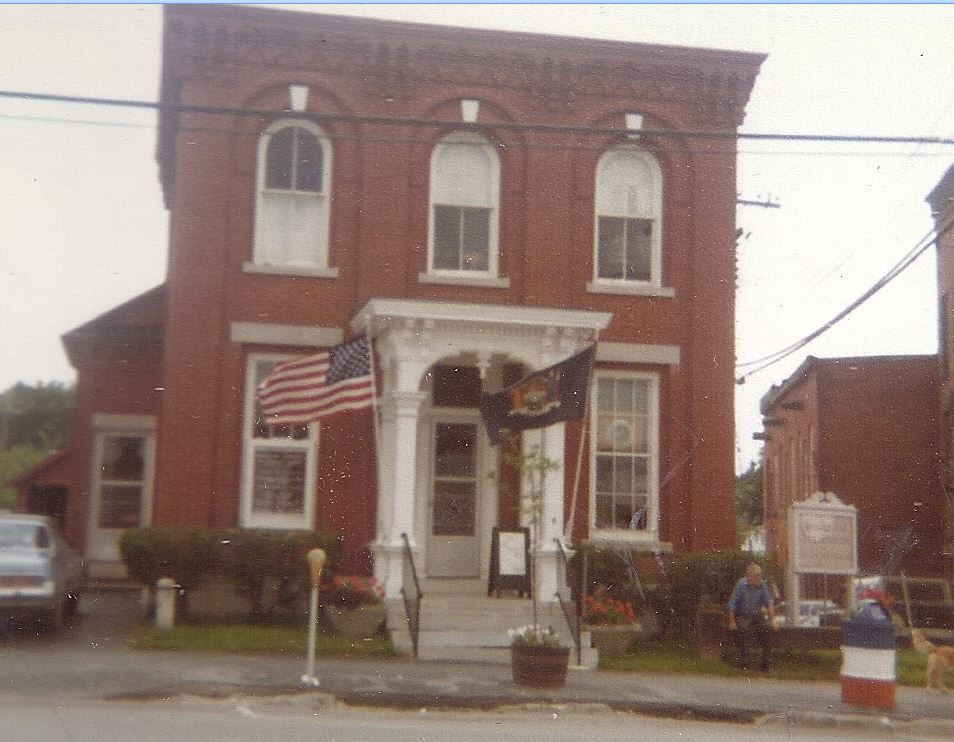
BELOW: Image from the 1909 Firemens' Souvenier Book:
Below in 1980 the Marine Midland Bank
BELOW:
Corner of Wardwell and East Church
Adams former rice residence.... This is a photo of
the graceful old home owned by C Kent rice and
family at the corner of East Church and Wardwell streets. It is shown
in the process of being torn down
to make room for the shopping area and Savings Bank
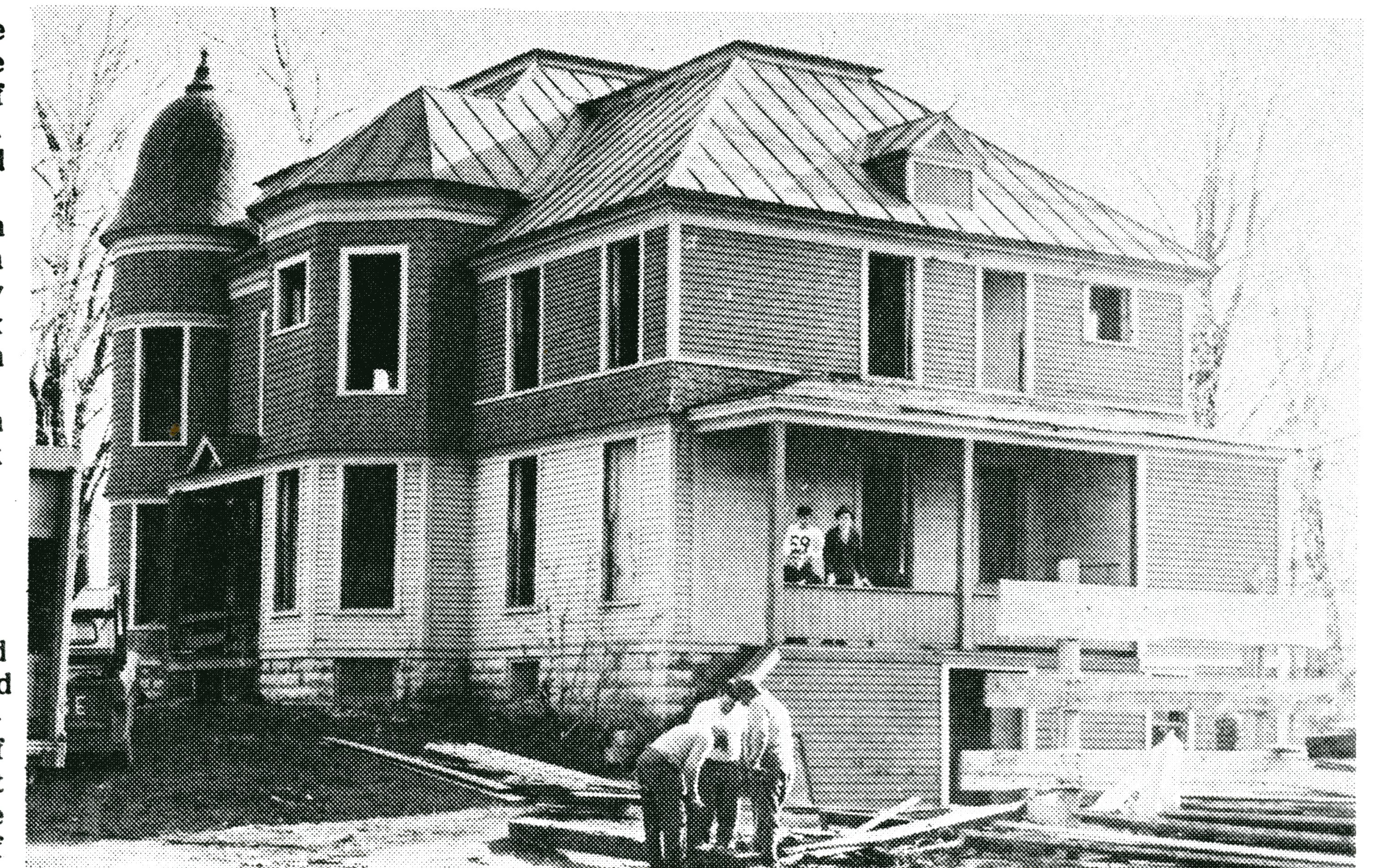
Below: Lisk Bridge 1980
Below: Lisk Bridge 1980
